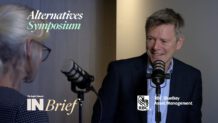Plotting the return to duration
Bond markets have effectively become the ‘freight train’ of a long series of other assets, with a surge in bond yields pulling nearly every other asset class lower. That is according to the team at Jamieson Coote Bonds, who managed over $5 billion across a series of long and active duration fixed income strategies.
Just a few months ago many viewed traditional long duration bonds as near uninvestable as the threat and beginning of more restrictive monetary policy hit global markets. Yet with the 10-year sovereign yield in both Australia and the US over 3 per cent already, the question becomes, when is the time to add back duration?
Speaking in the latest monthly update for their Dynamic Alpha strategy, which carries effectively zero duration at the current time, the portfolio managers Charlie Jamieson and Angus Coote, continue to warn that the market is pricing in an ‘aggressive’ amount of tightening, particularly in Australia. If correct, it is highly likely that bond yields will be forced lower amid the next, inevitable, market or credit crunch.
The bearish view on Australian yields is driven by a triumvirate of factors, starting with the conservative guidance given by the RBA, but extending into the more modest inflation profile and higher debt load, in the form of variable mortgages, that are prevalent in Australia.
“After warning of challenges for asset markets since the beginning of the year, April has delivered a wakeup call across many asset markets (ex-commodities), as the realisation that higher interest rates will dramatically affect not only bonds but have an outsized impact on corporate credit, equities and property” explained JCB.
They highlight the fact that the triple clutches of policy support continue to be withdrawn in 2022, that being QE, lower interest rates and fiscal spending, with economic momentum ‘slowing’ and a global recession now ‘widely expected into year-end’.
Whilst this might sound quite grim, there is one potential saviour, that is “lower inflation outcomes” which will force policy makers to slow down their aggressive tightening and release the brake peddle. And this is exactly what JCB expects, noting “without further shocks, inflation does look set to significantly moderate over the balance of the year after suffering a string of unexpected shocks which has kept expected inflation readings higher in the near term”.
It is only natural that such an aggressive switch in policy will lead to demand destruction, particularly given that central banks are using the ‘blunt instrument’ of higher rates to crush demand in an attempt to alleviate what is actually a supply-side pressure. Whilst aiming for a ‘soft landing’ in the economy is valiant, JCB don’t agree that dealing with these highly complex issues is quite that simple.
In terms of policy positioning, that group are awaiting a ‘period of stabilisation’ and signs that the slowdown in economic growth has permeated, before adding further duration. “Peak inflation and decent valuations as the US 10 year oscillates around 3.00% should provide a more stable investing environment in bonds”.
That is, of course, unless a ‘credit moment’ like that which occurred in March 2020 occurs once again. ‘Credit is a market of confidence’ but is always at risk of a moment when asset quality drops and liquidity becomes paramount, at which point, long-duration government debt would stand out as the only diversifier.











